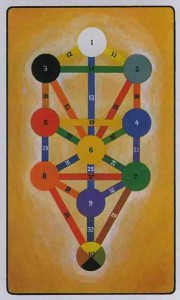What is agreed is that it is hard to clarify with any degree of certainty the exact concepts within Quaballah or the spelling of the word. There are several different schools of thought with very different outlooks; however, all schools of thought and spellings are accepted as correct.
I traded for this new deck. I consider it a gift. Thank you! I took out the cover card, shuffled the cards thoroughly, and drew— the Tree of Life. This is not a tarot card. It is included to help the reader relate each of the major arcana to the letters of the Hebrew alphabet. I should have removed it, but I did not know it was there. Nonetheless I drew it after just yesterday announcing I don’t understand the connection between Qabalah and tarot.
Today I learn: Kabbalah is associated with tarot because it has been so ever since the Order of the Golden Dawn drew up such associations. A man by the name of Court de Gebelin was the first to draw up connections between the 22 trump cards and the 22 letters of the Hebrew alphabet. Eliphas Lévi expanded on this idea.
What I did not realize in my hesitancy to study anything “too esoteric” is that the “commonly” accepted meanings of the tarot cards— those meanings which I have tried to interpret in my illustrations— were assigned based on Golden Dawn correspondences between: the Four Worlds of the Qaballah, the four suits of tarot cards, the 22 letters of the Hebrew alphabet, and the 22 major arcana. This makes comprehension of the tree of life integral to a simplified memorization or understanding of the common meanings assigned to tarot cards. It makes me (finally!) want to understand the tree of life and its correspondences— not because I believe that the Kabala is innately connected with what happens to be one of a number of variations of decks of cards initially designed for gambling— but because these correspondences are integral to the langue used to define the occult meanings the cards.
“The Founders of the Golden Dawn system appreciated that divination is nothing more (or less) than the effect of focusing attention on what would otherwise be a random distribution of variables, with the thought of some question, person or situation in mind. Theoretically, the intention stimulates the unconscious in some mysterious way, and in some equally mysterious way, the position of the variables under consideration is presumably affected. The variables could be bits of crumpled paper thrown down a flight of stairs if there were some initial decision made about what the landing order might mean.” —Robert Wang, An Introduction to the Golden Dawn Tarot




